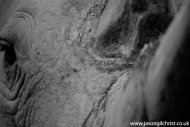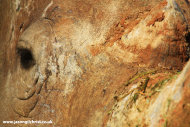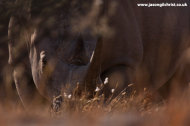Rhino!
Click on an image to your right, or on the subgallery title above, to view the images within the Rhino! subgalleries.
HOT OFF THE PRESS:
The near-extinction of rhinos is at risk of being normalised; published in The Conversation.
Javan rhinos, once thought safe from poachers, are anything but; published in The Conversation.
South Africa’s 70,000kg rhino horn stockpile must be burnt to prevent illegal trading; published in The Conversation.
Not so 'hot-off-the-press':
Farmed rhinos will soon ‘rewild’ the African savanna.
Rhinos: scientists are hanging them upside-down from helicopters – here’s why
Para ilmuwan berlomba selamatkan badak Sumatra sejak kematian pejantan terakhir di Malaysia (Indonesian translation of "Scientists race to save the Sumatran rhino as last male in Malaysia dies" [see below]).
Scientists race to save the Sumatran rhino as last male in Malaysia dies
Rhino horn must become a socially unacceptable product in Asia
Hybrid embryos raise hope of resurrecting northern white rhino – but what’s the point?
The Northern White Rhino Should Not Be Brought Back to Life, published in The Conversation.
Global Greed is Driving the Rhino to Extinction published in The Times for World Rhino Day 2017. I have more to say on the matters raised, re. wildlife crime, trafficking, promoting sustainable benefits to local communities, and demand reduction. Watch this space.
Also see recent article on rhino horn trade:

To Trade or Not to Trade? published in Biosphere Magazine.
To read my previous Conversation articles about rhino conservation visit:
‘Medical tourism’ to South Africa will only drive rhino closer to extinction, published in The Conversation. For World Rhino Day 2016 and CoP17 (the CITES conference: Convention on International Trade in Endangered Species of Wild Fauna and Flora).
Only a Jurassic Park-style intervention can now save the northern white rhino. You can read more of my thoughts on this in my Blog entry:Death of a Rhino.
Spy-cam rhinos to take on poachers with devices hidden in their horns (published for World Rhino Day 2015).
Chopping Off the Rhino's Horn and the War on Wildlife Crime.
To see a slideshow of my photos from rhino capture and de-horning, click White rhinoceros capture and de-horning - Chinese Torture.
To see video featuring GoPro footage of rhino darting from helicopter, click below (to see in full screen mode click the icon at bottom right of video screen).
Rhino I - darting from the air
To see video featuring GoPro footage of ground work on immobilised rhino, click below (to see in full screen mode click the icon at bottom right of video screen).
Rhino II - immobilised on the ground
Rhino poaching is arguably the most pressing wildlife conservation issue in the world today. The white rhinoceros (Ceratotherium simum) is an icon of African wildlife. The rhino’s horn is becoming an icon for bloody destruction.
The demand for rhino horn, principally driven by the eastern traditional Asian medicine market, makes rhino poaching a lucrative business for the criminals involved in the illegal trade; from the poachers through the handlers, brokers, buyers, and ultimately the misguided people who through faith, misplaced belief, and perhaps desperation, fuel the trade. There is no evidence that rhinoceros horn cures cancer, or that it diminishes fever. Rhino horn does not boost libido and fertility (but this has never been anything other than a minor contributor to demand). There is no evidence to justify or encourage a demand and trade that, at its current rate, will lead to the extinction of this dinosaurial large mammal.
Rhino horn is composed of keratin. Keratin is a protein common to and present in all mammals, including humans. Keratin makes up your fingernails and your hair. Imbibing a rhino horn ‘medicine’ is no more effective than drinking a cup of tea with the product of grinding up your own fingernails and hair.
Anti-poaching measures are not preventing a catastrophic exponential increase in the illegal killing of rhino, with an increase of 1200% from 2005 (455 killed between January and October 2012). This is unsustainable. Amongst the current mitigation measures, de-horning rhino is problematic; trauma can result in death, and poachers may kill rhino with limited horn growth, such is its value (greater than gold). Poisoning the horn of live rhino with an emetic (inducing sickness in humans ingesting the processed horn) is ethically controversial and requires capture and the associated risks to the rhino.
What can we do? Quite simply the rhino needs to be valued more alive than dead. How do we achieve this? We need to stop, or at least reduce, the rate of poaching. If the rhinoceros death rate exceeds the birth rate, then we are on a route to species extinction. Poaching can be reduced via two routes: (i) policing on the ground in Africa to discourage or prevent poaching, (ii) reduce the demand for rhino horn. Ultimately the latter is the most effective strategy. If people accept the science, the evidence, that rhino horn has no magic properties, then the demand will reduce. If the demand diminishes, the need, expense, and danger to people of protecting rhino on the ground in the wild is reduced.
Education, science, and information, need to be the long-term solution to the problem. Targeting the rhino horn market, the people on the street that ultimately drive the demand, via the facts, is the way forward. Critics say that we cannot overturn centuries of cultural tradition. But traditions evolve and themselves go extinct, that is how societies progress. We need to facilitate this so that killing rhino for pseudo-medicinal reasons becomes socially unacceptable – in east Asia and anywhere else where such ‘tradition’ endangers this and other species. The human species can be terribly short-sighted; if the rhino goes extinct so does the trade....
A third option is to protect rhino in captivity. In captivity, protection from poaching is far more effective. It is also possible to ‘farm’ rhino for their horn. Like hair and fingernails, rhino horn grows and it is possible to harvest it. This could be done within a legalised trade in rhino horn to reduce demand for poaching of wild rhino. These are not my ideal solutions. I want to see rhino out in the wild. However, they may be solutions that can be looked at in the short-term if we cannot get the current rate of poaching under control. Right now we need to consider all options; the situation is that serious.
What legacy will we leave with regard to the rhino? A world lacking this magnificent and ancient beast? Because rhino horn was worth more as a pseudo-cure than the species was worth as a wild animal taking its rightful place in the savannah ecosystem of Africa?
For more information on rhino, poaching, and solutions:
Save The Rhino
Project: African Rhino
World Wildlife Fund White Rhino
" new="true"]International Rhino Foundation
Humane Society International: Rhino Poaching
To read my articles on rhino anti-poaching actions (and the wider issue of wildlife and environmental crime) published by The Conversation, see Rhino horn must become a socially unacceptable product in Asia, Hybrid embryos raise hope of resurrecting northern white rhino – but what’s the point?, The Northern White Rhino Should Not Be Brought Back to Life, ‘Medical tourism’ to South Africa will only drive rhino closer to extinction, Spy-cam rhinos to take on poachers with devices hidden in their horns, and Chopping Off the Rhino's Horn and the War on Wildlife Crime. Also see Only a Jurassic Park-style intervention can now save the northern white rhino analysing the future for the northern white rhino. Also see To Trade or Not to Trade? published in Biosphere Magazine.
Who am I?
Who am I to be preaching about the importance of and risk to the world’s rhinoceros species? I lecture in Animal Biology at Edinburgh Napier University. I teach undergraduate and postgraduate courses on wildlife conservation and management. Over many years, I have conducted fieldwork and research in South Africa within the wildlife capture/translocation, and hunting industries. I have assisted in numerous white rhinoceros live captures and de-horning of rhino to reduce the risk of poaching.
To see a slideshow of my photos from rhino capture and de-horning, click White rhinoceros capture and de-horning - Chinese Torture.
To see video featuring GoPro footage of rhino darting from helicopter, click below (to see in full screen mode click the icon at bottom right of video screen).
Rhino I - darting from the air
To see video featuring GoPro footage of ground work on immobilised rhino, click below (to see in full screen mode click the icon at bottom right of video screen).
Rhino II - immobilised on the ground
HOT OFF THE PRESS:
The near-extinction of rhinos is at risk of being normalised; published in The Conversation.
Javan rhinos, once thought safe from poachers, are anything but; published in The Conversation.
South Africa’s 70,000kg rhino horn stockpile must be burnt to prevent illegal trading; published in The Conversation.
Not so 'hot-off-the-press':
Farmed rhinos will soon ‘rewild’ the African savanna.
Rhinos: scientists are hanging them upside-down from helicopters – here’s why
Para ilmuwan berlomba selamatkan badak Sumatra sejak kematian pejantan terakhir di Malaysia (Indonesian translation of "Scientists race to save the Sumatran rhino as last male in Malaysia dies" [see below]).
Scientists race to save the Sumatran rhino as last male in Malaysia dies
Rhino horn must become a socially unacceptable product in Asia
Hybrid embryos raise hope of resurrecting northern white rhino – but what’s the point?
The Northern White Rhino Should Not Be Brought Back to Life, published in The Conversation.
Global Greed is Driving the Rhino to Extinction published in The Times for World Rhino Day 2017. I have more to say on the matters raised, re. wildlife crime, trafficking, promoting sustainable benefits to local communities, and demand reduction. Watch this space.
Also see recent article on rhino horn trade:

To Trade or Not to Trade? published in Biosphere Magazine.
To read my previous Conversation articles about rhino conservation visit:
‘Medical tourism’ to South Africa will only drive rhino closer to extinction, published in The Conversation. For World Rhino Day 2016 and CoP17 (the CITES conference: Convention on International Trade in Endangered Species of Wild Fauna and Flora).
Only a Jurassic Park-style intervention can now save the northern white rhino. You can read more of my thoughts on this in my Blog entry:Death of a Rhino.
Spy-cam rhinos to take on poachers with devices hidden in their horns (published for World Rhino Day 2015).
Chopping Off the Rhino's Horn and the War on Wildlife Crime.
To see a slideshow of my photos from rhino capture and de-horning, click White rhinoceros capture and de-horning - Chinese Torture.
To see video featuring GoPro footage of rhino darting from helicopter, click below (to see in full screen mode click the icon at bottom right of video screen).
Rhino I - darting from the air
To see video featuring GoPro footage of ground work on immobilised rhino, click below (to see in full screen mode click the icon at bottom right of video screen).
Rhino II - immobilised on the ground
Rhino poaching is arguably the most pressing wildlife conservation issue in the world today. The white rhinoceros (Ceratotherium simum) is an icon of African wildlife. The rhino’s horn is becoming an icon for bloody destruction.
The demand for rhino horn, principally driven by the eastern traditional Asian medicine market, makes rhino poaching a lucrative business for the criminals involved in the illegal trade; from the poachers through the handlers, brokers, buyers, and ultimately the misguided people who through faith, misplaced belief, and perhaps desperation, fuel the trade. There is no evidence that rhinoceros horn cures cancer, or that it diminishes fever. Rhino horn does not boost libido and fertility (but this has never been anything other than a minor contributor to demand). There is no evidence to justify or encourage a demand and trade that, at its current rate, will lead to the extinction of this dinosaurial large mammal.
Rhino horn is composed of keratin. Keratin is a protein common to and present in all mammals, including humans. Keratin makes up your fingernails and your hair. Imbibing a rhino horn ‘medicine’ is no more effective than drinking a cup of tea with the product of grinding up your own fingernails and hair.
Anti-poaching measures are not preventing a catastrophic exponential increase in the illegal killing of rhino, with an increase of 1200% from 2005 (455 killed between January and October 2012). This is unsustainable. Amongst the current mitigation measures, de-horning rhino is problematic; trauma can result in death, and poachers may kill rhino with limited horn growth, such is its value (greater than gold). Poisoning the horn of live rhino with an emetic (inducing sickness in humans ingesting the processed horn) is ethically controversial and requires capture and the associated risks to the rhino.
What can we do? Quite simply the rhino needs to be valued more alive than dead. How do we achieve this? We need to stop, or at least reduce, the rate of poaching. If the rhinoceros death rate exceeds the birth rate, then we are on a route to species extinction. Poaching can be reduced via two routes: (i) policing on the ground in Africa to discourage or prevent poaching, (ii) reduce the demand for rhino horn. Ultimately the latter is the most effective strategy. If people accept the science, the evidence, that rhino horn has no magic properties, then the demand will reduce. If the demand diminishes, the need, expense, and danger to people of protecting rhino on the ground in the wild is reduced.
Education, science, and information, need to be the long-term solution to the problem. Targeting the rhino horn market, the people on the street that ultimately drive the demand, via the facts, is the way forward. Critics say that we cannot overturn centuries of cultural tradition. But traditions evolve and themselves go extinct, that is how societies progress. We need to facilitate this so that killing rhino for pseudo-medicinal reasons becomes socially unacceptable – in east Asia and anywhere else where such ‘tradition’ endangers this and other species. The human species can be terribly short-sighted; if the rhino goes extinct so does the trade....
A third option is to protect rhino in captivity. In captivity, protection from poaching is far more effective. It is also possible to ‘farm’ rhino for their horn. Like hair and fingernails, rhino horn grows and it is possible to harvest it. This could be done within a legalised trade in rhino horn to reduce demand for poaching of wild rhino. These are not my ideal solutions. I want to see rhino out in the wild. However, they may be solutions that can be looked at in the short-term if we cannot get the current rate of poaching under control. Right now we need to consider all options; the situation is that serious.
What legacy will we leave with regard to the rhino? A world lacking this magnificent and ancient beast? Because rhino horn was worth more as a pseudo-cure than the species was worth as a wild animal taking its rightful place in the savannah ecosystem of Africa?
For more information on rhino, poaching, and solutions:
Save The Rhino
Project: African Rhino
World Wildlife Fund White Rhino
" new="true"]International Rhino Foundation
Humane Society International: Rhino Poaching
To read my articles on rhino anti-poaching actions (and the wider issue of wildlife and environmental crime) published by The Conversation, see Rhino horn must become a socially unacceptable product in Asia, Hybrid embryos raise hope of resurrecting northern white rhino – but what’s the point?, The Northern White Rhino Should Not Be Brought Back to Life, ‘Medical tourism’ to South Africa will only drive rhino closer to extinction, Spy-cam rhinos to take on poachers with devices hidden in their horns, and Chopping Off the Rhino's Horn and the War on Wildlife Crime. Also see Only a Jurassic Park-style intervention can now save the northern white rhino analysing the future for the northern white rhino. Also see To Trade or Not to Trade? published in Biosphere Magazine.
Who am I?
Who am I to be preaching about the importance of and risk to the world’s rhinoceros species? I lecture in Animal Biology at Edinburgh Napier University. I teach undergraduate and postgraduate courses on wildlife conservation and management. Over many years, I have conducted fieldwork and research in South Africa within the wildlife capture/translocation, and hunting industries. I have assisted in numerous white rhinoceros live captures and de-horning of rhino to reduce the risk of poaching.
To see a slideshow of my photos from rhino capture and de-horning, click White rhinoceros capture and de-horning - Chinese Torture.
To see video featuring GoPro footage of rhino darting from helicopter, click below (to see in full screen mode click the icon at bottom right of video screen).
Rhino I - darting from the air
To see video featuring GoPro footage of ground work on immobilised rhino, click below (to see in full screen mode click the icon at bottom right of video screen).
Rhino II - immobilised on the ground







